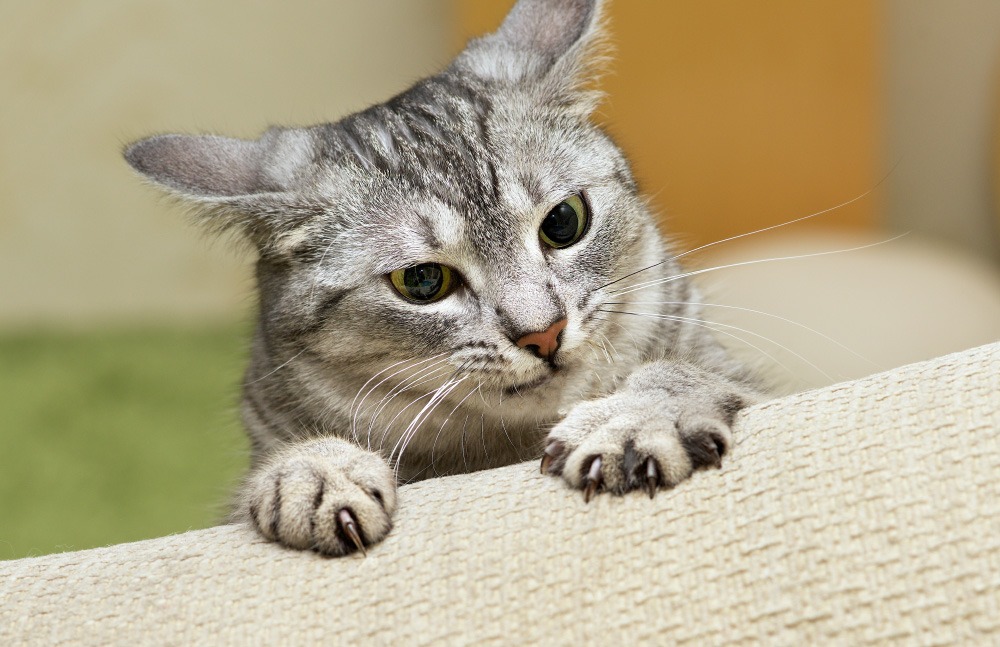
27 Sep Declawing: Don’t Do It. Here’s Why.
Declawing a cat is more than removal of the cat’s nail. Cats’ claws are part of their toe bones. The procedure known as “declawing” is the surgical removal of the entire end of the cat’s toe, chopping off the bone and cutting through the attaching ligaments and tendon. A more accurate term would be “de-knuckling.” The declawing operation itself is the human equivalent of removing the first joint of all your fingers.
Cats use their claws to exercise, play, stretch, climb, hunt and mark their territory. Declawing is neither an effective nor a compassionate way to deal with a cat’s unwanted scratching. Although your cat might use your hands or furniture for these activities, there are many other ways to guide your cat to healthy claw activity!
“Declawing
Veterinary experts report that the lack of these joints impairs the cat’s balance and can cause weakness from muscular disease. Declawing also makes a cat feel defenseless and can affect their personality, making them skittish or nervous biters. In rescue work, we see many declawed cats that have been given up by their owners because the cats still had behavioral problems that were made worse by not having their claws
Declawing is never the answer for anything. Take it from an expert, Dr. Nicholas Dodman, author of The Cat Who Cried For Help, who offers this perspective on the procedure:
“Declawing involves more than simply trimming a cat’s nails to the quick; it actually involves amputation of the tips of the digits, bones and all. The inhumanity of the procedure is clearly demonstrated by the nature of cats’ recovery from anesthesia following the surgery. Unlike routine recoveries, including recovery from neutering surgeries, which are fairly peaceful, declawing surgery results in cats bouncing off the walls of the recovery cage because of excruciating pain. Cats that are more stoic huddle in the corner of the recovery cage, immobilized in a state of helplessness, presumably by the overwhelming pain. Declawing fits the dictionary definition of mutilation to a tee. Words such as deform, disfigure, disjoint, and dismember all apply to this surgery. Partial digital amputation is so horrible that it has been employed for torture of prisoners of war, and in veterinary medicine, the clinical procedure servesas a model of severe pain for testing the efficacy of analgesic drugs. Even though analgesic drugs can be used postoperatively, they rarely are, and their effects are incomplete and transient anyway, so sooner or later the pain will emerge.”
There are much better — and more effective — alternatives to declawing. Exercise and play with your cat regularly. Give him or her a scratching post or a corrugated cardboard scratcher to use. Trim your cat’s nails on a regular basis. And, of course, talk to your vet or cat-owner friends about ways to “train” your cat to exercise its natural instincts in non-destructive ways. A squirt bottle is a great way to teach a cat not to scratch on particular surfaces. It doesn’t hurt them and if you are persistent, they will get the message. There is also a product called Soft Paws. This is a fake nail which is not sharp at the tip, which fits over your cats claws. It is sold in pet stores and veterinarian clinics.
Lastly, declawing cats is illegal in many parts of the U.S., including:
- Beverly Hills
- Burbank
- Culver City
- Los Angeles
- Santa Monica
- West Hollywood
If you are adamant about having a kitty without claws, we strongly urge you to consider adopting a previously-declawed kitty. Contact us and we can help you.
Here are some other web pages with great information on the declaw procedure:
The Paw Project – a movement to make declawing illegal nation-wide
Declawing Alternatives
Humane Society Fact Sheet on Declawing
Words About Declawing from a Vet Technician
How To Keep Your Cat Happy and Still Keep Your Furniture and Sanity Intact


